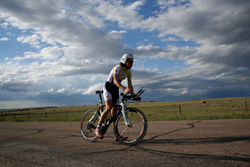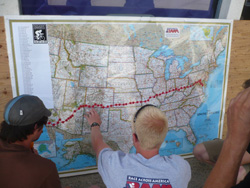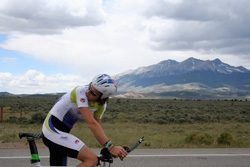|
The Ride of a Lifetime
Cycling team comprised of diabetics takes top spot in Race Across America
Ioana Patringenaru | July 19, 2010

Team Type 1, on the left, and Team Type 2 pose for a group picture.
It took UC San Diego graduate student James Stout and seven of his teammates exactly five days, 10 hours and 48 minutes to bike 3,005 miles between Oceanside, Calif. and Annapolis, Md. Their performance earned them the top spot in the Race Across America, a grueling, non-stop competition that traverses much of the country.
Their win is all the more remarkable because Stout and all of his teammates suffer from Type 1 diabetes, a chronic disease that is more severe than Type 2 diabetes and disproportionately strikes children and the young. “Not bad for a bunch of invalids on bikes,” is how Stout put it.
During his cross-country adventure, Stout struggled with altitude sickness, fluctuating levels of blood sugar, devilish climbs and tricky hills. But it was worth it, he said, and not just because the team bested other athletes who don’t suffer from the condition. Team Type 1 already claimed victory in the same competition in 2007 and 2009.

Stout on the road.
Everywhere they went, Stout and his teammates got to educate the public about diabetes and treatments available to treat the disease. Stout also said he was amazed by the turnout from the team’s supporters. Taking part in the race also was a great way to get to know the United States, said the UCSD graduate student, who came here from England.
Managing diabetes
Managing their diabetes was a constant challenge for Team Type 1 riders, who come from all walks of life and from all over the United States. “You have to treat it like a constant, five-day exercise bout,” Stout said. His teammates wore monitors that checked blood sugar levels throughout the day. Stout estimates he checked his a total of about 200 times. Teammates also wore devices that administered insulin when levels became too low.
Stout said he felt extremely lucky to have a wide array of technologies at his service to help him manage his condition. During the race, he got to meet a woman whose daughter died of complications from Type 1 diabetes.
The fans

Cyclists examine the course for the Race Across America.
Related story:
Cycling Against the Odds
Graduate student with Type 1 diabetes competes as part of top cycling squad.
He also said he was amazed at how communities rallied around his team. Spectators drove for hours to watch them race, filling up parking lots at fast food restaurants in small towns all over America late into the night. When one of Stout’s teammates crashed, a bike shop owner whose daughter suffered from Type 1 diabetes opened his store at 2 a.m. to make repairs. Firefighters in Kansas opened up their station to the riders and cooked for them.
“They absolutely idolized us,” said Stout, who said he had trouble understanding why. “They’re going into burning buildings and rescuing people. I ride my bike around.”
The race day to day
Well, not quite. The Race Across America is a team relay competition. That means the race never stops, day or night. To keep up with this grueling rhythm, Team Type 1 split riders into two groups. They called themselves team “shake” and team “bake.” On a typical day, a group of four riders put in six- to eight- hour shifts, then was relieved by the other group. Within these six to eight hours, athletes rode 20 minutes at a time as fast as they could. They then waited their turn for their next relay in a chase car.
When their shift was over, they adjourned to the team’s RV, where they tried to get some sleep for three to five hours. They also consumed as much food as they needed to keep their blood sugar levels stable. Some days, Stout ate 4,000 calories. “We used to wake up and eat ice cream at gas stations,” he said.
Ice cream for breakfast wasn’t unusual, but Stout tried to stick with the healthier alternative of oatmeal with raisins, nuts and butter. A chef prepared healthy meals, including omelets, couscous and burritos. The riders also filled up on snacks, such as cut-up fruit, candy, pretzels and even peanut-butter-and-Nutella sandwiches.
Discovering America

James Stout waits to take over from a teammate.
All that fuel was necessary to conquer the road ahead. Asked about a difficult stretch in the race, Stout recalled his climb up Old Castle Road at the foot of Mount Palomar in north San Diego County. “I went way harder than was sensible,” he said. “I went off that bike and I was sick.” He thought he wouldn’t last another five days. But he did. On the way, he discovered he liked east Arizona. “Flagstaff and Jerome are great places,” he said. He clocked at 60 mph during his descent into the town of Jerome.
He also rode on a bridge over a lake in the Ozarks mountain range in the middle of the night. Darkness surrounded him, punctuated by lights from homes flickering across the water. Another favorite moment was riding through Gettysburg, again at night. “All you could hear was your own breathing,” Stout said. “It was spooky.” At that point, Stout’s team knew they had a lock on the race. “I felt amazing,” he said. “I could have ridden all day.”
Stout said he will likely be riding in the race again next year. The team’s goal will be the same, he said: to educate the public about diabetes—and to beat their own time record, which they set in 2009.

|